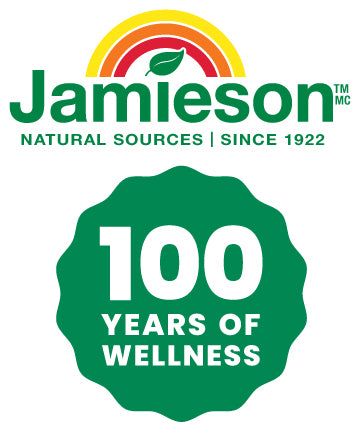Did you know many Canadians are not receiving the required amount of vitamin D suggested by Health Canada? Statistics Canada has stated that when blood levels of vitamin D were tested, about 40% of Canadians were below the cut-off level for healthy bones in winter, compared with 25% in the summer”.[1]
Lack of vitamin D from the sun
Compared to all other vitamins, vitamin D is unique as it can be made by the body through exposure to sunlight. This is why it is commonly known as the “sunshine vitamin”. However, the body's ability to produce vitamin D from the sun can be affected by many factors such as:
Distance from the sun (latitude, season, time of day). In Canada during the winter, there are fewer ultraviolet B (UVB) photons reaching the earth. This translates to very little, if any, vitamin D being produced in the winter by your body.
Coverage Cloud cover, smog, full clothing, and sunscreen use all block exposure to the sun. Research is showing that covering up and wearing sunscreen (when applied consistency and properly) is impairing our body’s ability to make vitamin D.[2] Although these are important sun safety measures to avoid skin cancer, ensuring you receive vitamin D through food or supplementation is also essential for your health.
Skin pigmentation Melanin in the skin evolved as an effective natural sunscreen. Those with darker skin pigment, or more melanin, have increased difficulty producing vitamin D from the sun.
Age is also a factor as the body's ability to produce vitamin D from the sun declines as we grow older. For example, a person aged 70 makes, on average, 25% of the vitamin D that a 20-year-old makes when exposed to the same amount of sunlight.¹
Lack of vitamin D from food sources
You might think because you eat a varied diet, you are consuming enough vitamin D. Unfortunately, vitamin D is only found in the following few foods:
- Fatty fish and egg yolks are the only 2 natural Canadian food sources.
- Cow’s milk and margarine in Canada are legally required to be fortified with vitamin D, meaning they have had supplemental vitamin D added to them.
- Goat’s milk, plant-based beverages (e.g., soy beverages), and orange juices are permitted to be fortified with vitamin D but are not required. Basically, if it’s not written on the front of the container, chances are it doesn’t have it.
- Cheese and yogurt can be made with vitamin D-fortified milk; however, they will not contain as much vitamin D as cow’s milk alone.¹
- Mushrooms are the only vegan source available for vitamin D,[3] yet the amount is dependent on how much exposure to UV lights the farmers give them. They also lose 20-30% of vitamin D after only 1 week of storage.[4]
- Breast milk is known to be the best source of nutrients for a baby’s healthy development, yet it often contains only small amounts of vitamin D. According to the Canadian Paediactric Society “Maternal vitamin D deficiency during pregnancy and breastfeeding is common and contributes to the low vitamin D content of breast milk. Without further supplementation, both preterm and full-term breastfed infants may be at risk for vitamin D deficiency”.[5]
Vitamin D is an important nutrient as it plays numerous roles which affect our health. According to Health Canada, vitamin D helps to support immune function, and helps in the absorption and use of phosphorus and calcium which help to build strong bones and teeth. When vitamin D is combined with sufficient calcium intake, a healthy diet and regular exercise, it may reduce the risk of developing osteoporosis.[6]
How much vitamin D do you need?
The chart below shows the combined daily amount of vitamin D from foods and supplements that Health Canada states is required for good health (RDA) as well as the UL (the highest level you should safely take).[7] Please note that vitamin D is a fat-soluble vitamin, meaning that we store it in our fat cells, and it is possible to consume too much.
|
Age group |
Recommended Dietary Allowance (RDA) per day |
Tolerable Upper Intake Level (UL) per day |
|
Infants 0-6 months |
400 IU (10 mcg) (Adequate Intake rather than Recommended Dietary Allowance.) |
1000 IU (25 mcg) |
|
Infants 7-12 months |
400 IU (10 mcg) (Adequate Intake rather than Recommended Dietary Allowance.) |
1500 IU (38 mcg) |
|
Children 1-3 years |
600 IU (15 mcg) |
2500 IU (63 mcg) |
|
Children 4-8 years |
600 IU (15 mcg) |
3000 IU (75 mcg) |
|
Children and Adults |
600 IU (15 mcg) |
4000 IU (100 mcg) |
|
Adults > 70 years |
800 IU (20 mcg) |
4000 IU (100 mcg) |
|
Pregnancy & Lactation |
600 IU (15 mcg) |
4000 IU (100 mcg) |
Infant vitamin D intake: A joint statement provided for health care professionals by Health Canada, Canadian Paediatric Society, Dietitians of Canada and the Breastfeeding Committee for Canada, recommends: “a daily vitamin D supplement of 10 µg (400 IU) for infants and young children who are breastfed or receiving breast milk”.[8] The Canadian Paediatric Society also recommends “an increase to 800 IU/day from all sources between October and April north of the 55th parallel (approximate latitude of Edmonton) and between the 40th and 55th parallel in individuals with risk factors for vitamin D deficiency other than latitude alone.”⁵
Children vitamin D intake: Vitamin D is important for children as it helps in the development and maintenance of their growing bones as well as their teeth.⁶ “In children, low levels of vitamin D can cause rickets, a condition characterized by soft bones and skeletal deformities.”¹ According to the Canadian Paediatric Society, “the emphasis is no longer solely on preventing rickets…The focus is now also on the prevention of associated childhood and adult diseases…It is now clear that vitamin D is involved in the regulation of cell growth, immunity and cell metabolism. Vitamin D receptors are found in most tissues and cells in the body… [which] may result in a variety of biological responses influencing disease processes.” ⁵
According to the Canadian Journal of Public Health “many children did not meet the estimated average requirements (EAR) for vitamin D from dietary sources and milk consumption… Given trends towards a more sedentary lifestyle and limited sun exposure, we recommend prioritizing public health efforts to support dietary vitamin D intake...”[9]
Adult vitamin D intake: For adults the range is between 800 IU and 4000 IU. Currently 1000 IU is the highest daily amount allowed by Health Canada in a daily supplement, which is why that is the number most often suggested. However, some individuals may require up to 4000 IU, if prescribed by their doctor (usually after a blood test is taken). Most adults do well at 1000 IU, but to verify your own unique needs, you can request a vitamin D blood test from your doctor.
Sources
[1] Janz, T. & Pearson, C. Vitamin D blood levels of Canadians. Statistics Canada Catalogue no. 82624-x. Accessed Oct 10, 2019 at: https://www.statcan.gc.ca/pub/82-624-x/2013001/article/11727-eng.htm
[2] Bens G. (2014). Sunscreens. Adv Exp Med Biol. 810:429-63.
[3] Linus Pauling Institute Micronutrient Information Centre. Vitamin D. Accessed Oct 10, 2019 at: https://lpi.oregonstate.edu/mic/vitamins/vitamin-D#food-sources
[4] Mushrooms Canada. Commercialization of Vitamin D Enhanced Mushrooms by UV Light Treatment. Accessed Oct 10, 2019 at: https://www.mushrooms.ca/wp-content/uploads/2016/01/Commercialization-of-Vitamin-D-Enhanced-Mushrooms.pdf
[5] The Canadian Paediatric Society. Vitamin D supplementation: Recommendations for Canadian mothers and infants. Accessed Aug 19, 2019 at: https://www.cps.ca/en/documents/position/vitamin-d
[6] Health Canada. Multivitamin Mineral Monograph. Accessed Oct 10, 2019 at: http://webprod.hc-sc.gc.ca/nhpid-bdipsn/atReq.do?atid=multi_vitmin_suppl&lang=eng
[7]Health Canada. (2012). “Vitamin D and Calcium: Updated Dietary Reference Intakes”. Accessed Oct 10, 2019 at: https://www.canada.ca/en/health-canada/services/food-nutrition/healthy-eating/vitamins-minerals/vitamin-calcium-updated-dietary-reference-intakes-nutrition.html#a10
[8] Health Canada. Nutrition for Healthy Term Infants: Recommendations from Six to 24 Months. Accessed Oct 10, 2019 at: https://www.canada.ca/en/health-canada/services/canada-food-guide/resources/infantfeeding/
nutrition-healthy-term-infants-recommendations-birth-six-months/6-24-months.html
[9] Colapinto CK, et al. (2014). Obesity, lifestyle and socio-economic determinants of vitamin D intake: A population-based study of Canadian children. Can J Public Health.105(6):e418-24.




